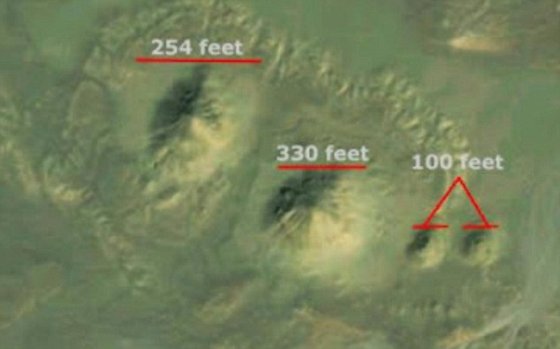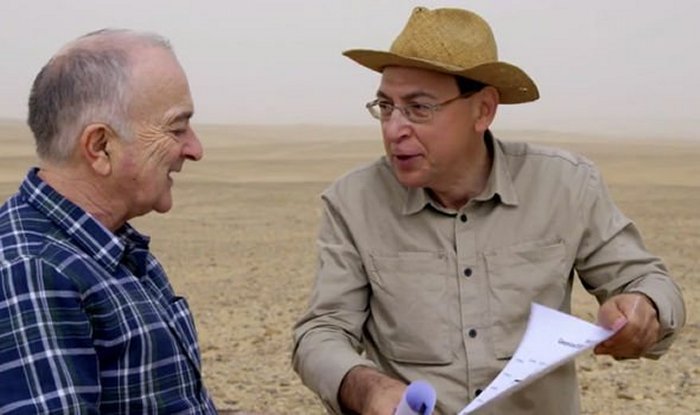Conny Waters - AncientPages.com - After spending extensive time scanning the desert of Sahara an archaeologist announced he has found a new site where a large structure is hidden beneath the sand in the Egyptian desert.
Could it be a new pyramid? No-one knows how many more pyramids could be hiding beneath the sand in Egypt.
Some years ago, satellite images revealed strange structures in the Sahara Desert. Abu Sidhum Site, Egypt- View from Google Earth. Image credit: Angela Micol
Some years ago, Angela Micol, founder of The Satellite Archaeology Foundation, Inc. announced satellite images revealed intriguing and mysterious structures in the Sahara Desert. Micol said the constructions were either damaged pyramids or antediluvian remains. Based on the satellite imagery, Micol suggested that the mounds might represent eroded pyramids, but no-one took her claims seriously.
Perhaps this skeptical attitude will change now when Dr. Vasko Dobrev who spent the last three decades probing the area just 19 miles from the world-famous Pyramids of Giza made a similar statement.
Earlier this year, his finds were revealed during Tony Robinson’s Channel 5 documentary “Opening Egypt’s Great Tomb”.
Dr. Dobrev explains to Tony Robinson something large is hidden beneath the sand. Credit: Channel 5
“I’ve travelled over 400 miles north of Aswan, but this is no sightseeing tour.
Dr. Vasko Dobrev has been working in the desert outside Cairo for the past 30 years and he’s on the hunt for a new pyramid.
Often we only think of the famous pyramids of Giza, but this site called Saqqara boasts the first pyramid and a great many more.
Pyramids here spanned six centuries of Egyptian history, but one dynasty of pharaohs, in particular, chose to build their magnificent tombs in Saqqara,” Tony Robinson said.
Now, Dr. Dobrev has shocked not only Robinson, but the entire world stating numerous pyramids could be hiding beneath the sand.
“There are about 120 pyramids all around Egypt.
Pharaohs built pyramids here because Saqqara is exactly in front of the capital of Egypt, Memphis, “Dr. Dobrev said.
Pharaoh Hor Aha is credited with founding the city of Memphis at a strategic spot. The identity of Pharaoh Aha has been debated and it’s possible he was the legendary Menes, the first monarch who used different names and united Egypt.
Left: Statue of hor Aha - Credit: antikforever.com - Right: An artist's impression of Memphis, Egypt. (From the computer game Assassin's Creed Origins)
Dr. Dobrev thinks a top of a flat plateau in the desert is the site where an ancient pyramid is hidden, but it’s unknown who built it.
He suggests it may have been constructed by Pharaoh Userkare who didn’t reign for more than three or four years.
“He could not finish a 52-meter-high pyramid in three years. He may have only had time to create the pyramid base. We are on a good height, we discovered that all the pyramids that are in Saqqara, they are on the same level.
See also:
Pi-Ramesse: Pharaoh Ramesses II’s Great Capital That Was Found In Two Locations
How The Hyksos Invasion Of Ancient Egypt Changed History
Kingdom Of Mitanni: Forgotten For Millennia But Once Great Power Of Ancient West Asia In 2000 BC
Abydos: One Of The Most Important Cities Of Ancient Egypt
City Of Sais: Prehistoric Prestigious Cult Center Of Northern Egypt
So there is a kind of pyramid level and we have his father to the north, his son is just there and his grandson is behind us.
But we have something else, new technology, geophysics, shows something with right angles.
This is not naturally made, we have a kind of square here, 80 by 80 meters, which is exactly the size of the pyramids of that period,” Dr. Dobrev explains.
Archaeologists Abd el-Monem who analyzed the ancient inscriptions thinks it could have been the tomb of Imhotep.
During his life, Imhotep accomplished many things that made him remembered long after his death. He was well-known for his intelligence and wisdom. Imhotep, or "he who comes in peace," was an ancient Egyptian genius and the great architect of the world's first known monumental stone building, the Step Pyramid at Sakkara.
The full scan of the area showed the right angles. Credit: Channel 5
“So far about nine tombs have been found. They broke in by using mechanical digging loaders and this was maybe more than 25, 30 people per night.
The main goal for them was to steal treasure. This was the tomb of Imhotep,” Abd el-Monem said.
We may have to wait a little longer before we learn what kind of ancient structure Dr. Dobrev discovered. Currently, the nature of this ancient structure remains undetermined. Considering the fact that in ancient times, some thousand years ago, this vast area was fertile grassland, there are many reasons to think more ancient structures could be hidden beneath the sand awaiting our discovery.
Flowing rivers across the Sahara desert 100,000 years ago. Credit: Tom Coulthard Ramirez JA, Barton N, Rogerson M, Brücher T (2013)
Scientists are still debating what changed the green Sahara into a desert. Some years ago a megalake as large as Lake Michigan was discovered beneath the Sahara Desert.
Researchers found that three ancient river systems, now buried, may have created viable routes for human migration across the Sahara to the Mediterranean region about 100,000 years ago.
Taking into consideration the effects of climate change, one can only expect to find many new marvels from ancient times buried deep beneath the sand in Egypt.
Written by Conny Waters - AncientPages.com Staff Writer








